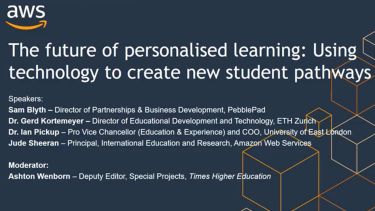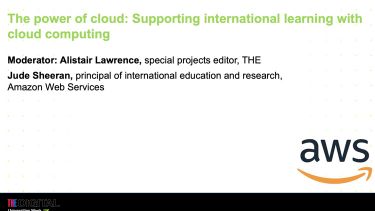By allowing faculty to deliver quality flexible teaching to students, new technologies help improve the university experience for all students
The Covid-19 pandemic has not only accelerated the shift towards digitalisation in higher education but also forced universities to entirely rethink course design and delivery.
At a webinar hosted by Times Higher Education and Amazon Web Services (AWS) – titled “Improving access and delivering quality flexible learning and assessment” – experts discussed the benefits and challenges that online learning and assessment have brought over the past 12 months and what they mean for the future of education.
Through his experience working with the sector during this time, Paul Feldman, CEO of Jisc, said he had seen a “real hunger” among universities to “build back better”.
The shift to remote learning had been largely successful, Feldman noted, and there was “unanimity this is the direction to go in”. But key to making the transition a success in the longer term would be to focus more attention on the student experience.
The jobs of the future will require different skill sets, and higher education needs to become much more flexible. “What a lawyer in 2020 looks like will be very different to a lawyer in 2040,” Feldman said. “Graduates need to be able to come back to their institutions to get the skills needed for their next stage of their life.”
He also predicted that degree courses would see a permanent shift to a January start in the coming years, with many institutions adopting a “hop on, hop off” system whereby learners could start modules at different points in the year.
Neil Morris, interim deputy vice-chancellor for digital transformation at the University of Leeds, agreed that the pandemic had forced his institution to revise its existing approach. “Our normal education government broke down completely,” he said. “Actually, that was really powerful because it meant we heard lots more voices than we perhaps normally do.”
But while staff were “taken by surprise” at how well students adapted to remote learning, a lack of in-person meetings raised concerns that vulnerable students could slip through the cracks, Morris added.
When used responsibly, new technologies could provide ways to monitor student safety and well-being, said Jude Sheeran, head of international education strategy at AWS.
“We’re trying to help a number of universities develop or use technologies that will enable them to unobtrusively and ethically predict when students are under pressure and feeling the strain of their studies, especially in a remote and environment,” he explained.
Initiatives had already proven successful in this field, panellists heard, including one programme at Arizona State University that used machine learning to monitor students’ progress and alert course leaders when an individual was likely to fail the semester.
Collecting data was undoubtedly a “sensitive subject”, Feldman said, but not utilising it to monitor student well-being would be irresponsible. “Finding the right way to intervene to support students is crucial,” he explained, warning that universities had already seen “an epidemic pre-Covid” of underlying mental health problems.
Transitioning to effective online assessment could also provide solutions in this regard, Morris said. Automated assessments, for example, could free up time for staff to concentrate on student well-being.
“I'm really keen to champion the automation of administration to the point where colleagues are able to devote the time they need to critical activities,” said Morris. “Assessment is a really good example of the potential of digital technology to really support personalised education…It’s a really exciting space where I think we will see a massive transformation.”
Covid has been “perhaps the most challenging Rubik’s Cube of interrelated issues in the sector space for 1,000 years”, Sheehan reflected. “It has also presented the greatest array of opportunities, thanks to the advent of all these available and emerging technologies.”
Find out more about Amazon Web Services’ work in the public sector.








